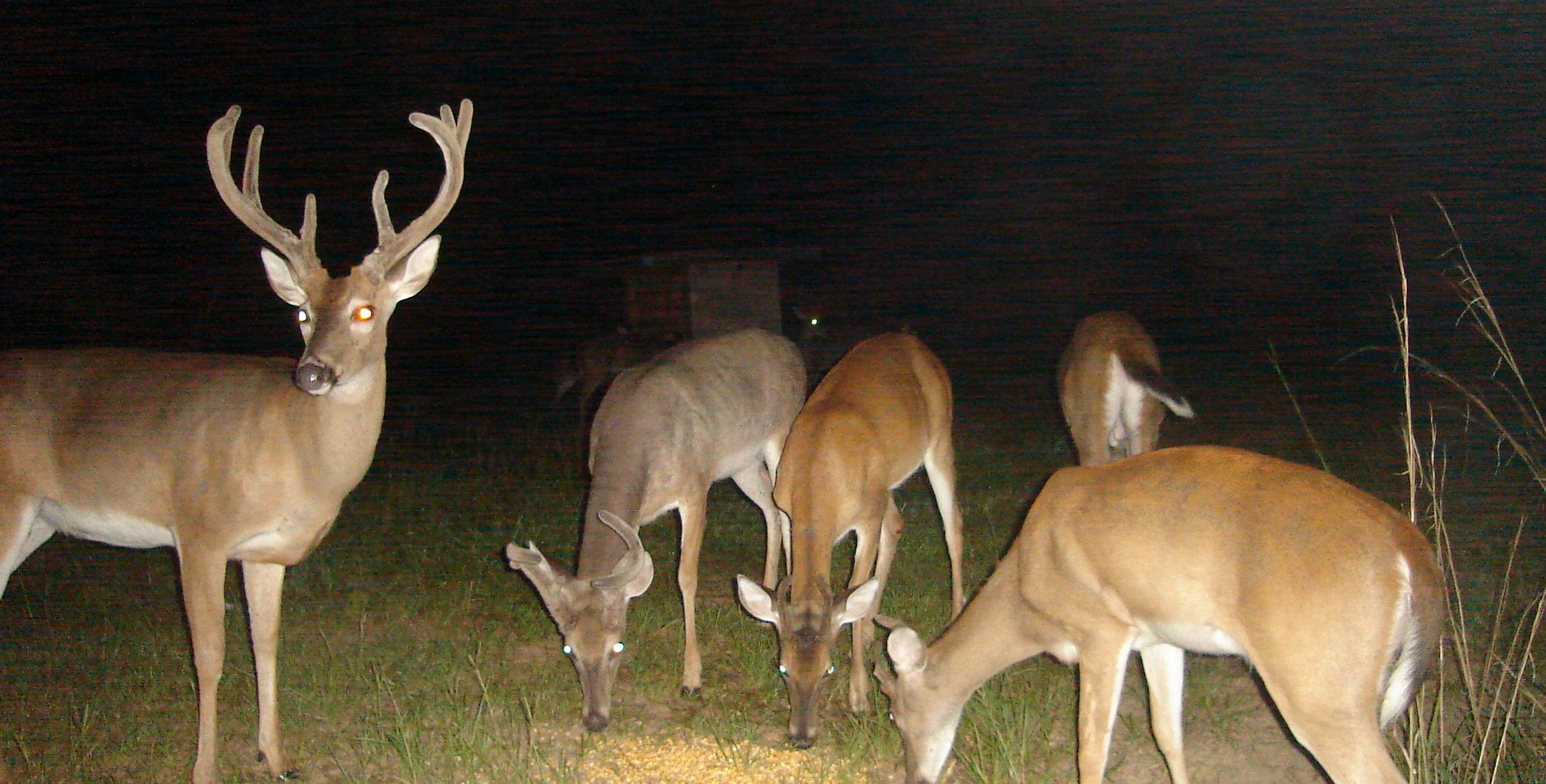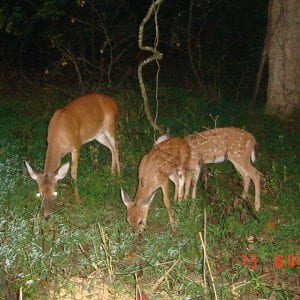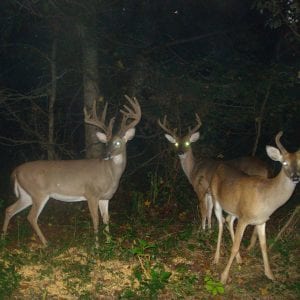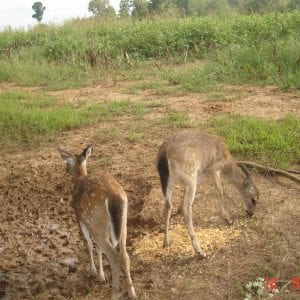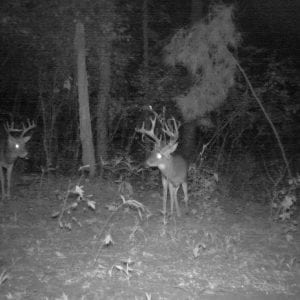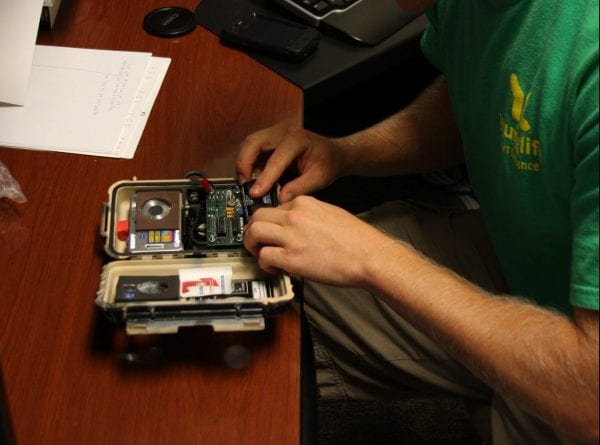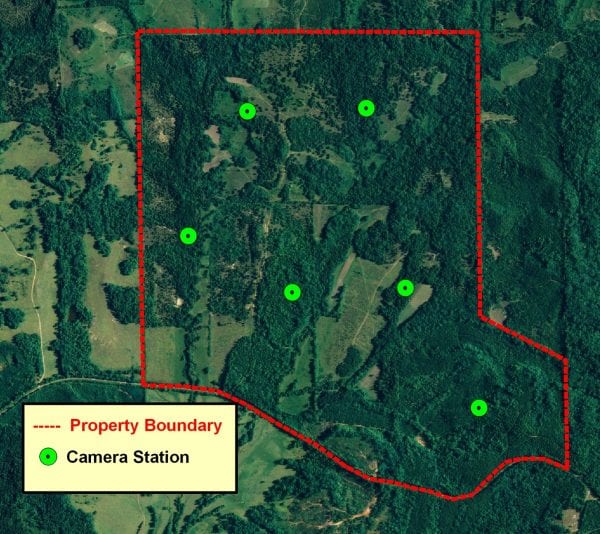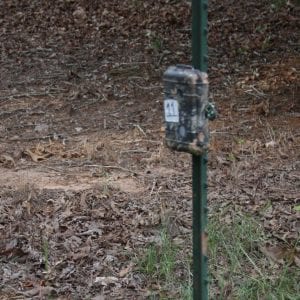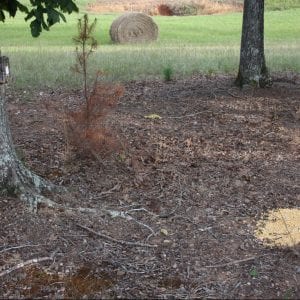Forestry & Wildlife

Landowners and hunters continually seek new tools, information, and techniques for managing white-tailed deer on their properties. One technique that has grown quite popular is the use of game cameras to conduct surveys of local deer herds.
Since the late 1980s, researchers have used game cameras to study numerous aspects of white-tailed deer ecology and biology. Advances in technology—mainly the advent of computers and digital cameras—have made the use of camera surveys a practical technique that can be easily used by all landowners. Vast improvements in the quality, storage capabilities, and durability of cameras have made camera surveys feasible, fun, and easy to do. Camera surveys can provide a wealth of information about local deer herds and provide landowners and hunters an opportunity to take an active role in deer management.
What Is a Camera Survey?
A camera survey is a management technique that allows landowners and hunters to gather information about the local deer herd. A camera survey consists of a game camera—preferably multiple game cameras—placed in the field to take pictures of deer. Bait, usually corn, is used to attract animals within the field of view of the camera. Most game cameras have an infrared trigger that detects animals and causes cameras to capture an image when deer are detected in the field of view. After a selected period of time, pictures are gathered from the cameras and printed or downloaded to a computer for viewing, analysis, and storage.
Deer Management by the Pictures
Pictures taken by game cameras can provide a wealth of information. The sex, relative age, general health, and antler growth of white-tailed deer can be assessed using images from game cameras. Landowners can also estimate fawn production, or recruitment, from camera surveys if they are conducted in a controlled, systematic fashion. Another advantage of camera surveys is that significant changes in herd characteristics can be identified if surveys are conducted over multiple seasons or years.
- Figure 2. If done properly, camera surveys can be used to index fawn recruitment..
- Figure 3. Pictures of bucks before the hunting season can be used to help hunters decide which bucks to harvest and which to protect from harvest.
Camera surveys give landowners important information about the overall composition of the local deer herd. This information can aid in developing sound harvest and management strategies. For example, prehunting season camera surveys allow hunters to identify which deer they want to harvest and which deer they want to protect. Camera surveys conducted after the hunting season are also beneficial and allow hunters to determine which deer survived the hunting season.
Although pictures can be used to gather some information about deer on a piece of property, it is still important to gather information, such as weight and age, from harvested deer. Harvest data provides critical information about herd health and composition and should be used in conjunction with game camera pictures to develop appropriate management recommendations.
Camera Considerations
A multitude of game cameras are available from several manufacturers for conducting camera surveys. Cameras have a host of different features, and prices range from less than $100 to several thousand dollars. Reliable cameras of good quality, however, can be obtained for a few hundred dollars. Below is an overview of some of the main points to consider before purchasing a game camera.
Triggering Mechanism
Game cameras can be classified as time-lapse, active, or passive systems. Older game cameras tended to be dedicated to one of these triggering systems; however, modern cameras often allow the user to select from multiple triggering options depending on the application. Time-lapse systems have no infrared beam or sensor and are set to take pictures at pre-programmed intervals (every 6 minutes, for example) regardless of whether an animal is present. Active and passive systems use infrared beams and sensors to trigger the camera to take pictures. Active systems emit an infrared beam and take a picture whenever the beam is broken. Passive systems have an infrared sensor that detects heat and motion and triggers the camera to take a picture when either is detected. These systems typically allow a user to select a predefined time interval between pictures when the infrared beam or sensor is not active and the camera does not take pictures. This “delay interval” period typically ranges from 1 to 30 minutes.
Which system is better is widely debated and will depend on many factors, including the intended use of the camera, location, storage capacity, battery consumption, and personal preference. For example, if you set up a game camera on a trail, you may want to use a passive or active system to be sure to capture an image at just the right moment. But if you have your camera set on a heavily used bait pile or feed station, it may be best to use a time-lapse system to reduce the number of repeat images of the same deer. Battery life and image storage capacity are very important considerations that may help you decide which system is best for a given application. Consider animal behavior around your camera, and make sure that you have sufficient battery life and storage capacity relative to the amount of time you plan to leave cameras in the field.
Visible Flash Versus Infrared Flash
Game cameras use either visible standard white flashes or infrared flashes, which are not visible during periods of low light. Cameras that use standard flashes will produce color and/or black and white images during day and night. Infrared flash cameras produce black and white images during night and usually take color pictures during the day. Although either type of camera likely is sufficient for conducting a survey, each has advantages and disadvantages that are important to consider.
- Figure 4. color game picture sample
- Figure 5. black and white game picture sample
Infrared cameras are less intrusive because they do not produce a visible flash. Use “stealthy” infrared cameras in situations where spooking animals or theft is a concern. Night photos from infrared cameras, however, are often lower resolution and quality than those captured by a standard flash camera. Standard flash cameras are more conspicuous, but the high quality color pictures can be very useful in identifying unique animals based on pelage (fur) color and patterns. Regardless of flash type, it is important to select a camera with an effective flash range between 30 and 50 feet so it can take quality pictures of deer at 20 to 30 feet.
Film Versus Digital
Digital cameras dominate the game camera market today and are much preferred over film cameras. Pictures taken by digital cameras can easily be downloaded to a computer, where images can be viewed, organized, analyzed, and cataloged. Digital cameras are comparable in price to film cameras, and long term costs associated with development of film are eliminated by digital cameras.
Battery Life and Power Source
Battery requirements and lifespan are another key feature to consider when purchasing a game camera. Remember, the more pictures a camera takes, the more battery power is used. Night pictures are especially draining on batteries because of the added power draw from the flash. If a camera will be left out in the field for an extended period of time, use a camera with a long battery life.
Some game cameras are equipped to accept external power sources, such as solar panels; however, most game cameras operate solely on batteries (e.g., AA, C, D). A good tip is to use rechargeable NIMH batteries or lithium batteries in your game cameras if you plan to leave them in the field for a long time. Alkaline batteries will drain much faster than these kinds of batteries in outdoor environments. To prevent possible damage, check the owner’s manual to be sure that your camera will accept rechargeable or lithium batteries.
Picture Resolution
Resolution, or image detail, refers to the number of pixels used to compose the digital image and is expressed in terms of megapixels (MP). Higher resolution produces greater detail, especially when zooming in on the picture. However, high resolution images also require much more memory space and reduce the number of pictures that can be stored on the camera. Game cameras with 3 to 6 MP of resolution are appropriate for most applications, and pictures of this resolution provide adequate detail when enlarged. Some cameras allow the user to select from a range of picture resolutions (e.g., 2, 4, or 6 MP). This is a very useful option because the user can set the game camera to take pictures at lower resolutions when desired allowing more pictures to be taken before the camera memory is filled. Conversely, picture quality can be adjusted to high resolutions when users want more detail in images.
Memory
Game cameras often take several pictures in one night of operation, so select a camera that has a large memory capacity. Most cameras have internal storage that may range from 64 MB to a few gigabytes (GB) of memory. Some game cameras use memory cards for additional external storage. These cards can substantially increase storage capacity, which is mandatory for high resolution cameras or in situations when pictures are downloaded infrequently. Memory cards are also convenient because they allow users to simply trade cards and leave cameras in the field when collecting pictures. This allows you to gather your pictures without bringing the camera home to download the pictures.
Programming
The ability to easily program the camera is essential. Programming may entail setting the date and time stamp format assigned to pictures, the delay interval between pictures, or the number of pictures taken when the camera is triggered. Most cameras have easy to read LCD displays used to program the unit. It is a good idea to experiment with several different game cameras before making a purchase to evaluate features and ensure that you are comfortable with the programming process.
Conducting a Camera Survey
Setting Up the Camera
It is a good idea to program the camera before heading out to the field. Depending on the make and model of the camera, you may have several options to program. Some of these may include:
- Date, time, temperature, and/or moon phase stamp format
- Picture or video mode
- Color or black and white
- Picture resolution
- Burst mode (shoot multiple pictures in rapid succession)
- Delay between pictures
- Video period length
- Time-lapse or infrared triggered
- Standard flash or infrared LED flash
- Day or night mode
Set the correct date and time on the camera before placing it in the field. Most cameras will stamp the date and time that each picture is taken—a great help as you organize and catalog pictures taken over multiple years.
The number of pictures taken each time the camera is triggered, commonly called “bursts,” can be set on many game cameras. The delay interval between pictures is another important feature that can be set on most game cameras. How you set your camera for bursts and the delay interval depends on your objectives.
Use a short delay (e.g., 10 seconds) and high number of bursts if you want to capture as many pictures as possible of individual animals. However, memory space and battery life may be consumed rapidly when using a high number of bursts and short delay intervals. Use a long delay (e.g., 10 minutes) and turn burst settings to zero if you want to maximize the length of time a camera can be left in the field without maintenance. Keep in mind, however, that your camera may miss some animals when using long delay intervals. A 5- to 10-minute minute delay interval is usually optimal for conducting a camera survey for deer.
The Camera Survey
The objectives of a survey must be determined before placing cameras in the field if you hope to conduct an effective survey that provides useful information about deer on your property. Once you have established objectives, ask three basic questions before conducting a camera survey: (1) when will the survey be conducted? (2) how long will the survey last? and (3) where will the camera(s) be placed?
Timing of the Survey
Camera surveys for deer typically are conducted in late summer or early fall before hunting season or late winter or early spring after the hunting season. Surveys are conducted during this time period because bucks possess antlers and deer will readily come to baited sites. Surveys sometimes are conducted during the hunting season; however, hunting near baited camera sites often violates game laws that limit hunting season surveys. The worst time to conduct a survey is in spring following the rapid plant growth, or green-up, period because deer do not come to bait well and bucks have very little visible antlers.
Seasonal behavior of deer should be considered when timing surveys. The rut (breeding season), which occurs approximately in mid-January in Alabama, can profoundly affect survey results. Bucks do not feed heavily during the rut and may not visit baited camera sites as frequently as during other periods of the year. Consequently, you may want to delay conducting a survey until after rutting activity has lessened. Birthing of fawns, which occurs about 200 days after a doe is bred, should also be considered if you want to estimate fawn production. In Alabama, the fawning season extends from mid-July until early September with a peak in mid-August. The survey must be conducted when fawns are old enough to be moving around but still young enough to be differentiated from yearlings. In Alabama, this is best done during late fall or early winter.
Length of the Survey
Survey length is just as important as survey timing. Surveys can be conducted for any length of time, but many white-tailed deer researchers agree that 7 to 10 consecutive days usually is sufficient time to get a good sample of the deer using a piece of property. You may want to run surveys for longer periods of time for increased opportunities to capture an image of an individual buck; however, bear in mind that only minimal additional information will be gained. Research at Mississippi State University indicates that surveys lasting 7 to 10 consecutive days are appropriate for accurately estimating deer density—number of deer/square mile—in areas that are high fenced. Your ability to accurately and precisely estimate deer density from camera surveys is greatly reduced in unfenced, or free-range, populations because deer are constantly moving on and off a piece of property.
Camera Density and Placement
Similar to survey timing and length, camera density is an important consideration. In general, using more cameras leads to a greater chance of getting more pictures of more deer and more information. Research from high-fenced areas shows that cameras distributed evenly at a density of 1 camera for every 41 to 65 ha (100 to 160 acres) is adequate for sampling a population of deer. This camera density is also a good general rule of thumb for free-range properties.
Place cameras strategically in areas of high deer activity, such as feeders, deer trails, scrapes, natural funnels, and water sources. Next, secure the camera to a tree or fence post located in the high activity area. Choose a tree at least 6 inches in diameter to limit false triggers associated with tree movement. A 6-foot t-post can be used if cameras are placed in areas where no other suitable objects are available for camera mounting.
Secure the camera about 3 feet above the ground and face it toward the area where deer are likely to cross or congregate. Cameras should be orientated north/south if possible so they are not directly facing the sun. Direct sun can cause poor quality pictures due to backlighting and “sunspots.” Direct heat from early morning and late afternoon sun near the horizon can also cause annoying false triggers if you are using an infrared trigger. Do not point cameras directly at highly reflective objects, such as metal feeders, as this can lead to false triggers.
Vegetation and other debris should be removed from the detection zone of the camera once the camera is in place. A single blade of grass waving in the wind can cause a camera to false trigger and lead to hundreds of empty pictures and wasted memory. Seemingly insignificant vegetation can also cause blurs in pictures from flash glare and block important features, such as antlers.
Bait can be placed within the detection zone of the camera if desired to further attract deer. Baits should be placed in front of the camera at a distance where the camera can easily detect deer but far enough away so that the entire deer is in the picture. Place the bait in a single pile about 8 to 10 feet from the camera. Placing the bait in one pile helps ensure that deer are in the best possible position when they are photographed. Placing bait at distances beyond 10 feet often leads to many images where deer are too far away to accurately classify for age, sex, antler size, etc.
- Figure 8. If necessary, use a t-post to correctly position cameras.
- Figure 9. Clear vegetation and place bait in one pile 8 to 10 feet from the camera.
Positives of Camera Surveys
- Less time and effort compared to most other monitoring techniques, such as spotlight counts, pellet counts, and drive counts
- Can be operated for extended periods
- Can collect vast amounts of data across large areas and can monitor large numbers of deer
- Enable landowners and hunters to see deer that reside or have visited their property
Negatives of Camera Surveys
- Not a substitute for collecting data from harvested deer
- Limited inference regarding the number and health of deer
- Require a substantial initial investment in cameras
- Can lose cameras to theft or vandalism
Trouble shooting
- Use cameras with infrared flashes if theft is a serious concern. Locks and protective devices are also available for these situations.
- Nontriggering and false triggering are the two most common problems associated with game cameras. Nontriggering occurs when an animal steps in front of the camera but the camera fails to take a picture, and false triggering occurs when there is no animal in front of the camera but the camera triggers and takes a picture. The occurrence of both of these events can be greatly reduced by strategically placing and orienting cameras.
- If you experience persistent triggering problems, refer to your owner’s manual and see if you can adjust the sensitivity of the infrared trigger. In general, sensitivity should be set lower if you are experiencing false triggers and higher with non-triggering issues.
- Raise the height of the camera or camera angle if pictures appear “whited-out” from flash blur. Vegetation around the flash can also cause problems with flash blur.
- Slightly raise the height of the camera or camera angle if you are getting numerous pictures of non-target species, such as raccoons and opossums.
- Low batteries can cause all kinds of camera malfunctions. Replace batteries before doing anything else if you are experiencing problems.
- Moisture inside camera cases can cause blurry pictures and damage electrical components. Do not open camera cases in rainy conditions or periods of high humidity, such as early in the morning, if possible. Always place moisture absorbing, or desiccant, packs inside the case to control moisture.
- Use a water-repellent product such as Rain-X on the interior and exterior of the glass around camera lens to help prevent buildup of condensation and water drops.
- Habitat conditions and weather can affect picture quality. If cameras are placed in areas of dense vegetation, it will be much more difficult to distinguish animals in pictures. The best time to conduct a survey is usually after leaves have fallen.
Using Baits
Baiting is a successful and easy way to improve success of camera surveys. However, baiting must be done legally and properly. Always contact your local wildlife law enforcement agency before using bait. These agencies can provide information on legal baiting seasons, types and amounts of bait that can be used, and other information concerning the use of baits. If baiting is illegal or is not a preferred option, cameras can be placed around food plots and natural food sources such as mast-producing trees.
If legal, shelled corn is a great bait to use when conducting camera surveys for deer. Corn can be readily purchased and is less expensive than most other types of bait. It is particularly important to note the potential for animal exposure to dangerous aflatoxins when using corn as bait. Aflatoxins are toxins produced by fungi. These fungi naturally occur and are commonly found in spoiled feed, especially cereal grains, peanuts, and corn. Consumption of aflatoxins by wildlife can be detrimental, causing suppression of the immune system, liver damage, cancer, and other negative effects. Aflatoxins not only are a concern for deer but they can also have significant impacts on turkeys and other wildlife. Corn should only be placed on the ground when surveys are being conducted and only required amounts should be used. Common sense dictates that you should limit the duration of a survey to the minimum time needed to collect information and limit the number of surveys conducted in a year. If other baits are used, similar issues should be examined and all necessary precautions taken.
The amount of bait used depends on camera location and type of bait. A general recommendation is to place 20 to 25 pounds of corn in a single pile at each camera station 5 days before the beginning of the survey and rebait the site as needed throughout the survey.
Important Points
Camera surveys are not the “silver bullet” for helping landowners/hunters manage deer populations. They are only another tool that can be used to help gather additional information about local deer populations. Collecting data from harvested animals each year, for example, is required for assessing overall herd health, for monitoring progress toward management objectives, and for making sound management decisions.
Drawing conclusions about a population of deer, such as density, based solely on pictures is generally a poor idea. Many factors not accounted for by a camera survey can substantially influence dynamics of a deer herd. For example, one of the greatest limitations of a camera survey is that it only provides a snapshot of a population in time. Just because a deer is alive and in a picture one day does not mean it will be alive or in the same place the next. Deer in free range populations are constantly moving across properties resulting in different deer on different properties at different times.
Information related to deer density is most useful when used in conjunction with data collected from hunter-harvested deer. Even when it is possible to accurately determine deer population density with game cameras, you still need to know the amount of deer the habitat can support (carrying capacity) in order to make management decisions. Data collected from hunter-harvested deer (e.g., weight, lactation rates) and vegetation surveys are important to assess population density relative to nutritional carrying capacity.
Changes in the availability of natural foods throughout the year also will substantially affect the number of deer visiting baited camera stations. For example, in good acorn crop years, it is common for deer to visit baited camera stations less frequently. This may result in fewer pictures of deer being taken and incorrectly leading one to believe that fewer deer are on the property. Habitat conditions present during the survey must always be considered when evaluating results from camera surveys.
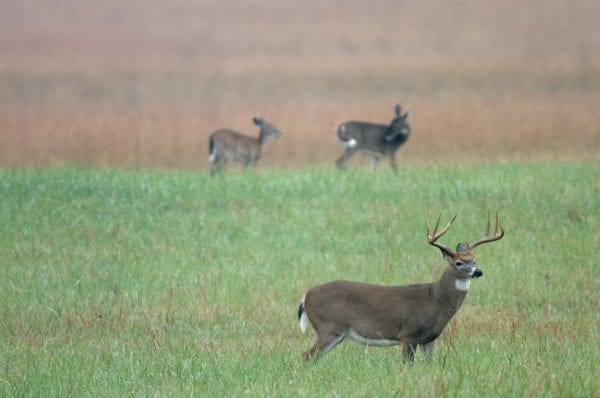
Figure 10. Camera surveys have limited ability for estimating deer density in freerange populations.
Additionally, all deer do not act the same and, consequently, all deer do not have the same chance of being photographed. Some individual deer may come to bait frequently while others may never visit the bait. Timing of the survey may play an important part in determining which deer are most likely to be photographed. Past studies have demonstrated that bucks (particularly mature bucks) exhibit highly variable visitation rates to bait sites. Bucks have higher visitation rates to baited sites during pre-rut than they do during the rut. In contrast, fawns tend to be highly visible at baited sites during the rut.
The complex interactions of multiple factors, including deer behavior and habitat conditions, can make estimating deer density from camera surveys extremely difficult, especially in free-ranging populations. Nonetheless, information from camera surveys provides another important piece of the puzzle when attempting to make sound deer management decisions. At the end of the day, a picture is worth a 1,000 words and a picture of a big buck means at least he was in front of your camera on that day.
Download a PDF of Managing White-tailed Deer: Camera Surveys, ANR-1395.

